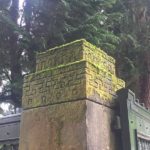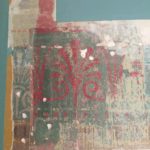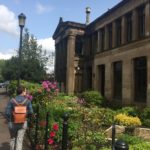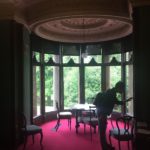A jaunt by train to see Greek Thomson’s Holmwood House.
It turns out to be undergoing major restoration work and it’s not quite what one would describe as “open,” but the volunteers on site let us in for a look around anyway. Disappointingly, nobody uses the expression, “caught with our pants down.”
We cannot see the upper floors of the house (though I glimpse of the famous dome by looking up through a scaffold) and we see the Greek fresco in the main downstairs room.
The guide who shows us around a little explains that the house was a convent for a large part of the twentieth century and that the nuns “obliterated” much of the Pagan imagery of Greek-o’s vision. The word, “obliterated,” makes me think of Friar Park, the English house restored by George Harrison, which is also sometimes said to have been “obliterated by nuns.”
Come on, nuns. Stop obliterating everything.
On the way home, we take a detour to see Moray Place, which was also designed by Thomson and where he lived for some years and eventually died. It is just around the corner from my very first Glasgow home on Marywood Square.
The urge to learn about Auld Greekie comes from my increasing awareness of how much of Glasgow was designed or built or inspired by Thomson. He sort-of built the world I live in: all of those columns and porticoes I see on my walks are his.





